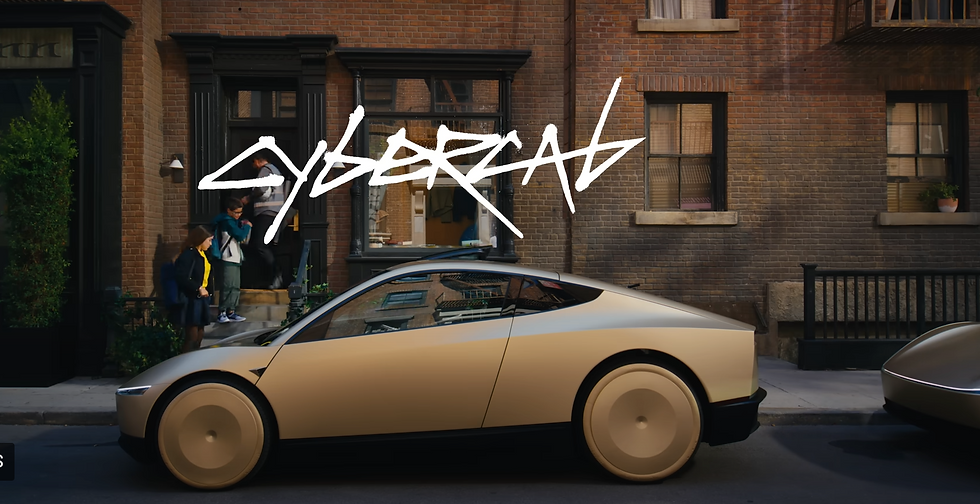The Unfolding Narrative of Tesla's Autonomous Taxi Fleet: Fact or Fiction?
- Mary

- Jan 31
- 4 min read
Tesla is making headlines once again with its ambitious plans for autonomous driving technology. Recently, CEO Elon Musk revealed that by June, Tesla will launch a fleet of autonomous vehicles operating as taxis in Austin, Texas. This bold announcement raises a critical question: is this the moment Tesla finally delivers on its promise, or are we just looking at another round of unmet expectations?
This announcement, made during Tesla's Q4 2024 earnings call, came alongside a stark drop in profits – from $7.9 billion last year to $2.3 billion this year. While the call focused on financial performance, it also pivoted towards the company’s long-awaited autonomous taxi service.
In this post, we’ll unpack Tesla's announcement, discuss the future of autonomous taxis, and analyze the dynamic landscape of this evolving technology.
A Recap of Musk's Bold Promises
Since 2019, Elon Musk has made several ambitious predictions about the future of Tesla's autonomous vehicles. At Tesla's Autonomy Day six years ago, Musk confidently claimed we would see "robotaxis" hitting the streets by 2020. Yet, here we are, years later, and those predictions remain unfulfilled.
Despite these challenges, Musk continues to press forward with the narrative, now focusing on a fleet of Tesla-owned autonomous taxis in Austin. This is a shift from earlier promises that included a platform for private owners to share their self-driving vehicles when not in use. This change indicates an awareness of previous criticisms regarding the initial rollout's feasibility, but it also raises new concerns about the timeline and execution.

The Cybercab and the Manufacturing Strategy
Last year, Tesla unveiled its Cybercab at Warner Bros. Studios, showcasing its features through a live demonstration. The company also introduced plans for a Cybervan, which will be able to autonomously transport larger groups. The Cybercab represents Tesla's vision of a purpose-built robotaxi that is set to enter mass production by 2026.
This ambitious manufacturing strategy uses an "unboxed" approach, diverging from the traditional auto manufacturing processes. While the concept excites many, waiting until 2026 raises questions about immediate consumer interest in Tesla’s offerings.
So, will the Cybercab fleet officially launch in June, or will Tesla face more delays?
The Competitive Landscape
Tesla is not alone in the race for autonomous vehicle technology. Waymo, a subsidiary of Alphabet, has been aggressively expanding its robotaxi services. In November 2023, Waymo made its rides available to everyone in Los Angeles. They are also incorporating their vehicles into freeway systems and planning expansions into cities like Atlanta and Austin.
With Waymo pushing to solidify its market presence, Tesla must find a way to set itself apart to gain a competitive edge. The rapid evolution of autonomous vehicles means that while Musk's aspirations may be ambitious, significant competition could limit Tesla's market share if they do not act quickly.

The Consumer Perspective
Understanding how consumers view autonomous vehicles is crucial. Safety concerns, reliability, and user expectations play significant roles in shaping public opinion. While many people are intrigued by the idea of driverless technology, there is also a sense of hesitation about fully autonomous rides.
To successfully introduce its taxi fleet, Tesla must tackle these concerns head-on. Demonstrating safety measures, protecting user data, and ensuring a reliable service are essential steps in gaining public trust. Although Tesla has cultivated a loyal customer base, the shift to a robotaxi service represents a critical change in how the brand is perceived.
The Road Ahead: Opportunities and Challenges
As Tesla moves forward, it's vital to recognize the mix of opportunities and challenges it faces with this new service. If it succeeds, Tesla's taxi fleet could change how we approach transportation and urban mobility.
Opportunities:
Market Leadership: Successfully launching an autonomous taxi service could place Tesla at the forefront of the driverless vehicle market.
Reduced Costs: A fleet of self-driving vehicles could lead to lower ride prices, improving accessibility for users.
Environmental Benefits: With its electric technology, Tesla can further promote eco-friendly ride options on a large scale.
Challenges:
Regulatory Hurdles: The regulatory environment will be complex as local and state governments evaluate the impacts of unmanned taxis.
Technological Barriers: The technology must be proven reliable across various driving conditions.
Public Acceptance: Winning the trust of potential users is crucial; without it, adoption may lag significantly.
Navigating these multifaceted challenges will determine how Tesla shapes the future of autonomous vehicles.
The Skepticism Factor
Given Musk's track record of grand promises, skepticism is only natural. Both investors and consumers are wary of potential over-promising and under-delivering. While there is a buzz about the prospects of autonomous taxis, it is essential to temper excitement with realism.
Despite previous timelines lapsing, Musk's announcements consistently generate interest. There’s undeniable energy surrounding Tesla's innovations. Yet, with each new claim, it's important to weigh the available evidence against the hype.
The Journey Ahead
Elon Musk's announcement regarding Tesla's autonomous taxi fleet, set to launch in June in Austin, raises many pivotal questions. As competition ramps up and technological hurdles become more pronounced, the world is watching intently. Will this be the year Tesla finally delivers on its promises, or will we see another chapter filled with waiting and disappointment?
The successful implementation of autonomous taxis relies on multiple factors, including the readiness of technology, regulatory frameworks, and the public's willingness to adopt. The future of Tesla's autonomous taxi fleet is still unwritten, and we are left to wonder what will happen next.

Looking ahead, it is hoped that advancements will lead to a successful integration of these innovative technologies into our daily lives. The answer to whether Tesla’s autonomous taxi fleet is a reality or simply fiction will reveal itself in the coming months.



Commentaires